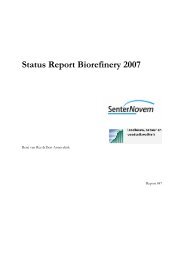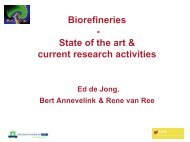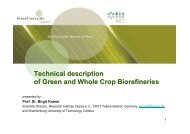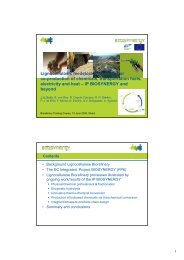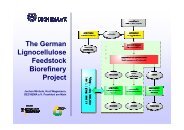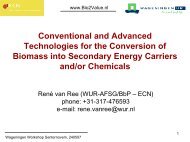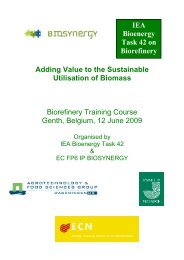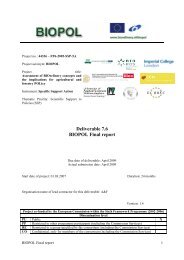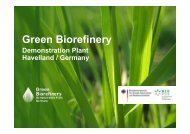Definition and technical status of Biorefineries - Biorefinery
Definition and technical status of Biorefineries - Biorefinery
Definition and technical status of Biorefineries - Biorefinery
You also want an ePaper? Increase the reach of your titles
YUMPU automatically turns print PDFs into web optimized ePapers that Google loves.
BioreFuture 2008, Tuesday 12 February 2008, Brussels<br />
Project no.: 44336-FP6-2005-SSP-5A<br />
Acronym: BIOPOL<br />
<strong>Definition</strong> <strong>and</strong> <strong>technical</strong> <strong>status</strong> <strong>of</strong><br />
<strong>Biorefineries</strong><br />
presented by:<br />
Pr<strong>of</strong>. Dr. Birgit Kamm<br />
Scientific Director, Research Institute biopos e.V., 14513 Teltow-Seeh<strong>of</strong>, Germany, kamm@biopos.de<br />
<strong>and</strong> Br<strong>and</strong>enburg University <strong>of</strong> Technology Cottbus<br />
1
Project no.: 44336-FP6-2005-SSP-5A<br />
Acronym: BIOPOL<br />
BioreFuture 2008, Tuesday 12 February 2008<br />
<strong>Definition</strong> <strong>and</strong> <strong>technical</strong> <strong>status</strong> <strong>of</strong> biorefineries<br />
Content:<br />
1. Introduction<br />
2. <strong>Definition</strong><br />
3. Systems<br />
4. Technical objectives <strong>and</strong> future solicitation<br />
5. Technical <strong>status</strong><br />
6. Platform chemicals<br />
7. Summary<br />
6. LCF <strong>Biorefinery</strong> Demonstration Plant<br />
2
1. Introduction<br />
<strong>Definition</strong> <strong>and</strong> <strong>technical</strong> <strong>status</strong> <strong>of</strong> biorefineries<br />
Biorefining is the transfer <strong>of</strong> the efficiency <strong>and</strong> logic<br />
<strong>of</strong> fossil-based chemistry <strong>and</strong> substantial converting<br />
industry as well as the production <strong>of</strong> energy onto the<br />
biomass industry.<br />
Kamm B, Gruber, P.R., Kamm, M.;<br />
<strong>Biorefineries</strong>, Industrial Processes <strong>and</strong> Products, Ullmann’s Encyclopedia <strong>of</strong> Industrial Chemistry,<br />
7th ed., WILEY-VCH, 2007<br />
3
1. Introduction<br />
Biobased Products<br />
Bio Economy<br />
Product <strong>and</strong> Energy Market<br />
BioEnergy / BioPower<br />
<strong>Biorefineries</strong><br />
Biogenic Raw Materials<br />
3-pillar model <strong>of</strong> a future<br />
biobased economy<br />
BioFuels<br />
It is absolutely necessary<br />
to develop solutions in three sustainable<br />
<strong>and</strong> biobased sectors:<br />
Biopower/Bioenergy (electricity <strong>and</strong> heat)<br />
Bi<strong>of</strong>uels (transportation fuels)<br />
Biobased Products (chemicals/materials)<br />
in context <strong>of</strong> a biobased economy.<br />
4
1. Introduction<br />
Fuels<br />
<strong>and</strong><br />
Energy<br />
Petroleum<br />
Chemistry<br />
Fuels<br />
<strong>and</strong><br />
Energy<br />
- Bioethanol,<br />
- Biodiesel, Biogas<br />
- Hydrogen<br />
Biomass<br />
Material Utilisation,<br />
Chemistry<br />
- Basic <strong>and</strong> Fine<br />
chemicals,<br />
- Biopolymers <strong>and</strong> Bioplastics<br />
Refinery <strong>Biorefinery</strong><br />
Biobased industrial products can only compete with petro-chemically<br />
based products if the raw materials are optimally exploited <strong>and</strong> a<br />
variety <strong>of</strong> value-creating chains are developed <strong>and</strong> established.<br />
development <strong>of</strong> substance-converting basic product systems <strong>and</strong><br />
multi product systems, especially biorefineries.<br />
5
2. <strong>Definition</strong><br />
<strong>Definition</strong> <strong>and</strong> <strong>technical</strong> <strong>status</strong> <strong>of</strong> biorefineries<br />
<strong>Biorefinery</strong> is the sustainable processing <strong>of</strong> biomass into<br />
spectrum <strong>of</strong> marketable products <strong>and</strong> energy.<br />
www.biorefinery.nl/biopol<br />
6
3. Systems<br />
<strong>Biorefineries</strong> combine necessary technologies between<br />
biological raw materials <strong>and</strong> the industrial intermediates <strong>and</strong> final products.<br />
Agriculture, Forestry<br />
Raw Material<br />
Special Substances:<br />
Pigments,<br />
Dyes,<br />
Aromatic Essences,<br />
Flavours,<br />
Enzymes,<br />
Hormones,<br />
<strong>and</strong> other<br />
Conversion <strong>of</strong><br />
Raw Material<br />
<strong>Biorefinery</strong><br />
Primary Refinery<br />
Complex<br />
Substances<br />
Inorganic<br />
Substances.<br />
Energy<br />
Carbohydrates<br />
After providing code-defined basic substances (via fractionation) it is<br />
necessary to develop industrially relevant Product Family Trees.<br />
Kamm, B.; Kamm, M.; Principles <strong>of</strong> <strong>Biorefineries</strong>. Appl. Microbiol, Biotechnol., (AMB), 64 (2004) 137-145<br />
Lignin<br />
Fats<br />
Proteins<br />
Special<br />
Substances<br />
Industry<br />
Product lines<br />
Product lines<br />
Product lines<br />
Product lines<br />
Product lines<br />
7
3. Systems<br />
Four <strong>Biorefinery</strong> Systems have been identified <strong>and</strong> described for<br />
research, development <strong>and</strong> practice:<br />
• The Whole Crop <strong>Biorefinery</strong> (WC-BR) (WC BR)<br />
raw material: cereals, maize etc..<br />
• The Green <strong>Biorefinery</strong> (G-BR) (G BR)<br />
raw material: ‘nature-wet’ biomasses, green grass, lucerne, clover,<br />
immature cereals a.o..<br />
The Lignocellulose Feedstock <strong>Biorefinery</strong> (LCF-BR) (LCF BR)<br />
• The<br />
raw material: ‘nature-dry’ biomasses, wood, straw, corn stover,<br />
cellulose-containing biomass <strong>and</strong> waste.<br />
The Two-Platform Two Platform Concept<br />
production <strong>of</strong> syngas <strong>and</strong>/or sugar as platforms for biobased<br />
products <strong>and</strong> fuels.<br />
www.biorefinery.nl/biopol<br />
8
Whole Crop <strong>Biorefinery</strong><br />
(dry mill)<br />
Lignocellulosic Feedstock<br />
<strong>Biorefinery</strong><br />
3. Systems<br />
Whole Crop<br />
Cereals<br />
- Dry Mill -<br />
Lignocellulosic<br />
Feedstock<br />
(LCF)<br />
Grain<br />
‘biotechn./chemical’<br />
‘physical/chemical’<br />
Flour (Meal)<br />
‘physical/chemical’<br />
Residues<br />
Cogeneration<br />
( CHP )<br />
Heat <strong>and</strong> Power<br />
Straw<br />
‘biotechn./chemical’<br />
Cellulose<br />
‘biotech./chemical’<br />
Residues<br />
Hemicellulose<br />
‘biotech./chemical’<br />
Cogeneration<br />
( CHP )<br />
Heat <strong>and</strong> Power<br />
Lignin<br />
‘chemical’<br />
Starch line,<br />
Sugar<br />
Raw material<br />
Fuels,<br />
Chemicals,<br />
Polymers <strong>and</strong><br />
Materials<br />
Lignocellulosic<br />
Raw material<br />
Sugar<br />
Raw material<br />
Fuels,<br />
Chemicals,<br />
Polymers <strong>and</strong><br />
Materials<br />
Lignin<br />
Raw material<br />
Green<br />
Biomass<br />
Techn. Press<br />
Biomass<br />
Press Juice<br />
‘biochemical’<br />
‘biotechnol./physical’<br />
Residues<br />
Biogas,<br />
Cogeneration<br />
( CHP )<br />
Heat <strong>and</strong> Power<br />
Residues<br />
Press Cake<br />
‘hydrothermal’<br />
‘enzymatic’<br />
‘ thermal chemical’<br />
Sugar Platform<br />
‘biochemical’<br />
Residues<br />
Cogeneration<br />
( CHP)<br />
Heat <strong>and</strong> Power<br />
Clean Gas<br />
SynGas Platform<br />
‘gasification’<br />
‘thermal chemical’<br />
Kamm, B.; Gruber, P.R.; Kamm, M.; <strong>Biorefineries</strong>, Industrial Processes <strong>and</strong> Products, Wiley-VCH, 2006<br />
Green <strong>Biorefinery</strong><br />
The Two-Platform Concept<br />
Proteins,<br />
Soluble Sugars<br />
Feed, Fuels,<br />
Chemicals,<br />
Polymers <strong>and</strong><br />
Materials<br />
Cellulose<br />
Lignocellulose<br />
Sugar<br />
Raw material<br />
Fuels,<br />
Chemicals,<br />
Polymers <strong>and</strong><br />
Materials<br />
conditioning<br />
Gas<br />
9
3. Technical Objectives & Future Solicitation<br />
Existing Starch<br />
Based<br />
<strong>Biorefineries</strong>: Wet &<br />
Dry Mills<br />
2000<br />
Integrated <strong>Biorefinery</strong> -Technical Objectives & Future Solicitations<br />
Completed solicitation<br />
Planed solicitation<br />
Fractionation<br />
<strong>of</strong> the feedstock to<br />
access the high value<br />
products prior<br />
ethanol production<br />
2005<br />
Increase ethanol<br />
production by access<br />
to residual starch &<br />
increased protein in<br />
co-products<br />
Fractionation <strong>of</strong><br />
residues in Dry<br />
Mills for new coproducts<br />
from<br />
lignin<br />
2010<br />
Kaempf, D.; 1 st International <strong>Biorefinery</strong> Workshop, Washington D.C.; July 20-21, 2005<br />
Integrated Industrial<br />
<strong>Biorefinery</strong>:<br />
multiple feedstocks<br />
fractionated to high<br />
value products for<br />
economics <strong>and</strong> fuel<br />
production drive scale<br />
2020<br />
Fractionation <strong>of</strong><br />
grain <strong>and</strong> residues,<br />
introduction <strong>of</strong> energy<br />
crops in dry mills<br />
10
Existing biorefineries, Phase I, (Selection)<br />
Plants<br />
Sugar <strong>and</strong><br />
Ethanol<br />
production<br />
Corn hydrolysis<br />
<strong>and</strong><br />
Ethanol<br />
Production<br />
Corn hydrolysis/<br />
Sugar <strong>and</strong><br />
Ethanol<br />
production<br />
BIOPOL, WP 1, Assessment Technical Status, 2007<br />
Raw material<br />
Sugar cane<br />
Maize corn<br />
Cereal Corn<br />
Sugar beet<br />
Country<br />
Brasilien<br />
17 billion litre/a<br />
U.S.A.<br />
22 billion litre/a<br />
EU<br />
1,5 billion litre/a<br />
In construction<br />
till mid 2008<br />
3,4 billion litre/a<br />
11
Existing biorefineries, Phase II, (Selection)<br />
Plants<br />
Corn hydrolysis<br />
& Lactic acid<br />
Fermentation &<br />
PLA production<br />
Corn hydrolysis<br />
& 1,3-Prop<strong>and</strong>iol<br />
Fermentation<br />
BIOPOL, WP 1, Assessment Technical Status, 2007<br />
Raw material<br />
Maize-Corn<br />
Maize<br />
Corn<br />
Country<br />
U.S.A.<br />
200 kt LA/a<br />
140 kt PLA/a<br />
U.S. A.<br />
45kt/a PDO<br />
In construction biorefineries, Phase II, (Selection)<br />
Plants<br />
Ethanol-<br />
Fermentation<br />
&Dehydration<br />
&PE Production<br />
Raw material<br />
Sugar cane<br />
Sugar cane<br />
Country<br />
Brazil<br />
(1) 350 kt/a<br />
Start 2011<br />
(2) 200kt/a<br />
12
Europe: In construction biorefineries, Phase II, (Selection)<br />
Plants/<br />
Company<br />
Country<br />
LCF biorefinery<br />
Abengoa Bioenergy<br />
Spain<br />
LCF biorefinery<br />
Icel<strong>and</strong>ic Biomass<br />
Icel<strong>and</strong><br />
Green biorefinery<br />
Austria<br />
Industrial Consortium<br />
Green biorefinery<br />
Germany<br />
Industrial Consortium<br />
BIOPOL, WP 1, Assessment Technical Status, 2007<br />
Raw material<br />
(Capacity)<br />
Corn stower<br />
Wheat straw<br />
Hay (70t/d)<br />
Alaska<br />
Lupine Straw<br />
Barley Straw<br />
Hay (20kt/yr)<br />
Grass<br />
(5t/h)<br />
Alfalfa/ wild<br />
mix grass<br />
(30kt/a)<br />
Main-Products<br />
Ethanol<br />
Lignin<br />
Ethanol<br />
Lignin<br />
Lactic acid,<br />
amino acid<br />
Fibres, biogas<br />
Proteins,<br />
Lactic acid<br />
Animal feeds,<br />
13<br />
biogas
Integrated <strong>Biorefinery</strong> Options<br />
Hydrolysis<br />
Acids, enzymes<br />
Gasification<br />
High heat, low<br />
oxygen<br />
Digestion<br />
Bacteria<br />
Pyrolysis<br />
Catalysis, Heat,<br />
Pressure<br />
Extraction<br />
Mechanical,<br />
Chemical<br />
Separation<br />
Mechanical,<br />
Chemical<br />
Sugars <strong>and</strong> Lignin<br />
Synthesis Gas<br />
Bio-Gas<br />
Bio-Oil<br />
Carbon-Rich Chains<br />
Plant Products<br />
Kaempf, D.; 1 st International <strong>Biorefinery</strong> Workshop, Washington D.C.; July 20-21, 2005<br />
Use:<br />
Fuels<br />
Ethanol<br />
Biodiesel<br />
Hydrogen<br />
Power<br />
Electricity<br />
Heat<br />
Chemicals<br />
Plastics<br />
Solvents<br />
Chemical<br />
Intermediates<br />
Phenolics<br />
Adhesives<br />
Furfural<br />
Fatty acids<br />
Acetic Acid<br />
Carbon black<br />
Paints, Dyes,<br />
Pigments,<br />
Ink, Detergents<br />
etc.<br />
Food & Feed<br />
14
Biomass<br />
Model <strong>of</strong> biobased Flow-chart for Biomass Feedstock<br />
Precursors<br />
Carbohydrates<br />
Starch<br />
Hemicellulose<br />
Cellulose<br />
Lignin<br />
Lipids, Oil<br />
Protein<br />
Platforms<br />
SynGas<br />
Sugar<br />
- Glucose<br />
- Fructose<br />
- Xylose<br />
Lignin<br />
Lipids/Oil<br />
Protein<br />
SynGas<br />
C1<br />
C2<br />
C3<br />
C4<br />
C5<br />
C6<br />
Aromatics<br />
Building<br />
Blocks<br />
direct<br />
Polymers<br />
Methanol<br />
Ethanol<br />
Glycerol<br />
Lactic acid<br />
Propionic<br />
acid<br />
Levulinic<br />
acid<br />
Furfural<br />
Lysine<br />
Gallic acid<br />
Secondary<br />
Chemicals<br />
Carnitine<br />
Intermediates<br />
Ether Fuel additives<br />
….<br />
Solvents<br />
Products/<br />
Uses<br />
Industrial<br />
Olefins Green solvents Transportation<br />
Diacids, Esters<br />
Dilactid<br />
Acrylate<br />
1,3-PDO<br />
Furane<br />
THF<br />
Caprolactam<br />
Phenolics<br />
Chemical<br />
intermediates<br />
Emulsifiers<br />
PLA<br />
Polyacrylate<br />
……<br />
…..<br />
Nylons<br />
Polyurethanes<br />
Resins<br />
Polysaccharides<br />
Textiles<br />
Safe Food Supply<br />
Environment<br />
Communication<br />
Housing<br />
Recreation<br />
Health a. Hygiene<br />
Kamm, B.; Gruber, P.R.; Kamm, M.; <strong>Biorefineries</strong>, Industrial Processes <strong>and</strong> Products, Wiley-VCH, 2006<br />
15
Synthesis <strong>of</strong> bifunctional aromatic <strong>and</strong> aliphatic chemical building blocks<br />
via LCF-<strong>Biorefinery</strong><br />
Project: Production segmented <strong>technical</strong> thermoplastic from renewable resources.<br />
Dow Deutschl<strong>and</strong>, Rheinmünster; FHG-ICT, Pfinztal, FI Biopos, Teltow, 2004-2007<br />
16
<strong>Biorefineries</strong> present :<br />
Complex <strong>and</strong> integrated systems <strong>of</strong> sustainable technologies<br />
based on biological raw materials.<br />
Economically self-consisting enterprises <strong>and</strong> economic entities.<br />
Bearing pillars <strong>of</strong> the future biobased economics.<br />
Motors <strong>of</strong> research <strong>and</strong> development in the 21th century.<br />
One fundamental task in the biorefinery topic is the development<br />
<strong>of</strong> biorefinery demonstration plants, close to<br />
Industry, agro-industry, <strong>and</strong> forest-industry.<br />
One example will be<br />
presented<br />
17
Future Vision for biobased products<br />
Types <strong>of</strong> Feedstocks<br />
• Grains<br />
(such as corn)<br />
• LC-Biomass<br />
(Lignocelluloses)<br />
Sources: Glassner, D.; NatureWorks LLC, 2005<br />
S<strong>of</strong>twoods Hardwoods Grasses<br />
Crop residues (e.g.,<br />
corn stover, cereal<br />
straw, sugar cane<br />
bagasse, etc.)<br />
18
Future Vision for biobased products<br />
Biomass Composition<br />
Cellulose<br />
(Chains <strong>of</strong> sugar)<br />
45%<br />
25%<br />
Hemicellulose<br />
(Chains <strong>of</strong> sugar)<br />
Other<br />
5%<br />
25%<br />
Lignin<br />
(Young clean coal)<br />
The whole plant-based (botanical) biomass consists <strong>of</strong><br />
approx. 70% carbohydrates!<br />
Biobased Carbohydrates Economy<br />
19
LCF <strong>Biorefinery</strong> Demonstration Plant<br />
The Icel<strong>and</strong>ic ethanol-oriented<br />
ethanol oriented biorefinery<br />
based on lignocelluloses<br />
Model project – Demonstration Plant –<br />
20.000 tons lignocelluloses/year<br />
20
Lignocellulosic<br />
Feedstock<br />
(LCF)<br />
Cellulose<br />
‘biotech./chemical’<br />
Residues<br />
Hemicellulose<br />
‘biotech./chemical’<br />
Cogeneration<br />
( CHP )<br />
Heat <strong>and</strong> Power<br />
Lignin<br />
‘chemical’<br />
Sugar<br />
Raw material<br />
Fuels,<br />
Chemicals,<br />
Polymers <strong>and</strong><br />
Materials<br />
Lignin<br />
Raw material<br />
General Scheme <strong>of</strong> a Lignocellulose Feedstock <strong>Biorefinery</strong><br />
21
No.<br />
group 1<br />
group 2<br />
group 3<br />
group 4<br />
group 5<br />
process lignocelluloses<br />
Tab. : Sources <strong>of</strong> lignocelluloses<br />
Source Groups<br />
existing l<strong>and</strong>scape species<br />
fast-growing plantations<br />
l<strong>and</strong>scape conservation<br />
used materials <strong>and</strong> waste<br />
Examples<br />
s<strong>of</strong>twood, hardwood, reed (Schilf), reed grass,<br />
switch grass, dry grasses etc.<br />
poplar (Pappel), willow (Weide), locust (Robinie),<br />
wood grass, eucalyptus, sudan grass<br />
old forest, residual wood <strong>and</strong> under-wood from<br />
forestry, switch grass, dry grasses, hay, straw<br />
straw, corn stover, press cake from crop drying<br />
plant, ethanol plants <strong>and</strong> oil mills, by-products<br />
from cereal mills, whole crop refineries, paper mill<br />
<strong>and</strong> pulp industry<br />
timber (Bauholz), used wood, recovered paper,<br />
cellulosic municipal solid waste<br />
22
Model <strong>of</strong> the Icel<strong>and</strong>ic ethanol-oriented biorefinery based on lignocelluloses<br />
Green SeePark Mývatn<br />
Modern Life, Working <strong>and</strong> Recovery with Nature in Northern Icel<strong>and</strong><br />
Regional Farmers<br />
• Biomass Producer<br />
Barley, Hey, Lupine<br />
• Vegetables Producer<br />
Salad, Tomato, a.o.<br />
• Animal husb<strong>and</strong>ry<br />
Sheep, Cattle<br />
Carbon dioxide<br />
Proteins, Yeast<br />
Fertilizer<br />
Fuel Industry<br />
Inhabitants<br />
Regional Jobs<br />
Biomass<br />
Energy<br />
Regional Sources<br />
Geothermal Heat<br />
Carbon dioxide<br />
Proteins<br />
Icel<strong>and</strong>ic <strong>Biorefinery</strong><br />
Biomass Conversion Mill<br />
Biobased Products Factory<br />
Chemical/Enzymatic Hydrolysis<br />
Conversion, Fermentation, Distillation<br />
Separation, Packaging, Storage<br />
Chemical <strong>and</strong><br />
Producing Industry<br />
Carbon dioxide<br />
Proteins<br />
Fertilizer<br />
Ethanol<br />
Lignin<br />
Tourism<br />
Educational Leave<br />
Hotel Sector<br />
23
The Icel<strong>and</strong>ic ethanol-oriented biorefinery (demonstration plant) - corner data<br />
Raw Material<br />
Lignocellulosic biomass (mix)<br />
Main Technologies<br />
Acid hydrolysis, Sugar fermentation<br />
Main Process Energy<br />
Geothermic steam<br />
Plant basis/Location<br />
Former Diatomite (Kieselguhr) Plant<br />
Main Product (Phase I)<br />
Ethanol for E10 Fuel<br />
Operating Company<br />
Icel<strong>and</strong>ic Biomass Company<br />
Total costs<br />
amount / prizes<br />
20.000 tons/year<br />
1,25 €/ton<br />
40.000 t /year<br />
7 Mio litres/year<br />
10 Mio €<br />
notes<br />
hey, lupine straw, barley straw<br />
modified “Bergius/Rheinau” process<br />
steam: 170°C /7 bar<br />
Northern Icel<strong>and</strong>, near sea Myvatn<br />
0,46 €/litres<br />
Main Seat : Reykjavik, IS<br />
Incl. accompanying R&D<br />
24
Advantages <strong>of</strong> the production <strong>of</strong> Ethanol<br />
Ethanol is not only a fuel, but also a basic chemical for a lot <strong>of</strong><br />
solvents, products <strong>and</strong> materials<br />
Diethyl ether<br />
Ether formation<br />
Acetone<br />
Keton synthesis<br />
Ethanol<br />
Esterification Lebedew Oxidation Dehydrating<br />
Process<br />
Ethyl lactate<br />
Ethyl<br />
levulinate<br />
other<br />
Acetaldehyde<br />
Butadiene Acetic acid<br />
Rubber<br />
Acetic<br />
anhydride<br />
Ethene<br />
Vinyl acetate<br />
Polymers<br />
Fuels<br />
Fuel additive<br />
Solvents<br />
Mobile Process<br />
Synthetic<br />
Naphtha<br />
Steam cracker<br />
Ethene<br />
Propylene<br />
C4-cut<br />
Benzine<br />
Crack gas<br />
Aromatics<br />
25
Summary<br />
Regional <strong>Biorefineries</strong> are also in other regions - without<br />
geothermic energy- pr<strong>of</strong>itable.<br />
For process energy it’s possible to use:<br />
The Lignin fraction, approx. 30% in lignocelluose<br />
the heating value (calorific value) <strong>of</strong> Lignin lies between 13 MJ/kg <strong>and</strong> 19 MJ/kg (DM)<br />
(wood: 18 MJ/kg, heating oil: 30-35 MJ/kg).<br />
Biogas Cogeneration: Heat <strong>and</strong> Power (Electricity).<br />
26
The Icel<strong>and</strong>ic Ethanol-oriented biorefinery – Summary<br />
The Icel<strong>and</strong>ic Ethanol-oriented <strong>Biorefinery</strong> (demonstration plant) can produce<br />
7 Mio litres Ethanol/year.<br />
The Icel<strong>and</strong>ic Ethanol-oriented LCF-<strong>Biorefinery</strong> is pr<strong>of</strong>itable!<br />
7 Mio l Ethanol (pure) is equivalent to 70 Mio E10 petrol.<br />
E10 petrol is normal petrol with 10% Ethanol.<br />
Each Icel<strong>and</strong>ic Inhabitant could to refuel approx. 233 Litres E10 petrol per year.<br />
27
The Icel<strong>and</strong>ic Ethanol-oriented <strong>Biorefinery</strong> – Summary<br />
Why is such (small scale) Ethanol-oriented LCF-<strong>Biorefinery</strong><br />
pr<strong>of</strong>itable?<br />
- Research <strong>and</strong> development supported by European Commission<br />
(BESUB project) <strong>and</strong> the Icel<strong>and</strong>ic Government.<br />
- Icel<strong>and</strong> has a very efficient <strong>and</strong> low price non-fossil energy market<br />
(geothermic energy). Hence, energy-intensive processes<br />
(e.g. acid recovery) are so economically <strong>and</strong> environmental-friendly.<br />
- Private Operating Companies, Finance <strong>and</strong> Government<br />
to act in concert.<br />
- Economical biomass <strong>and</strong> product markets could be<br />
organized (without subsidy).<br />
28
Presentation Summary<br />
Several requirements to enter the phase <strong>of</strong> development <strong>of</strong><br />
Industrial <strong>Biorefinery</strong> Technologies <strong>and</strong> Biobased Products:<br />
To increase the production <strong>of</strong> substances on the base <strong>of</strong><br />
biogenic raw materials in the ordinary plants <strong>of</strong> production <strong>of</strong><br />
cellulose, starch, protein, sugar <strong>and</strong> oil.<br />
To get the commitment <strong>of</strong> the chemistry, particularly the organic<br />
<strong>and</strong> <strong>technical</strong> chemistry, for the concept <strong>of</strong> biobased products<br />
<strong>and</strong> biorefinery systems.<br />
To force the combination <strong>of</strong> biological <strong>and</strong> chemical conversion<br />
<strong>of</strong> substances.<br />
To introduce <strong>and</strong> establish biorefinery demonstration plants.<br />
29
Contact<br />
Pr<strong>of</strong>. Dr. Birgit Kamm<br />
Director <strong>of</strong> the Institute Biopos e.V.<br />
<strong>and</strong> BTU Cottbus<br />
Research Centre Teltow-Seeh<strong>of</strong>,<br />
Kantstraße 55, D-14513 Teltow<br />
Email: kamm@biopos.de<br />
Web: www.biopos.de<br />
biorefinery.de company (GmbH)<br />
Main Seat: Stiftstraße 2, D-14471 Potsdam, Germany<br />
Email: <strong>of</strong>fice@biorefinery.de<br />
Laboratories Teltow-Seeh<strong>of</strong><br />
Kantstraße 55, D-14513 Teltow<br />
Web: www.biorefinery.de, www.biorefinica.de<br />
Potsdam <strong>and</strong> Teltow in the Greater Berlin,<br />
Germany<br />
30
City <strong>of</strong> Potsdam - Market Square<br />
State <strong>of</strong> Br<strong>and</strong>enburg,<br />
Greater Berlin, Germany<br />
Thank you for the invitation <strong>and</strong><br />
your attention<br />
31



